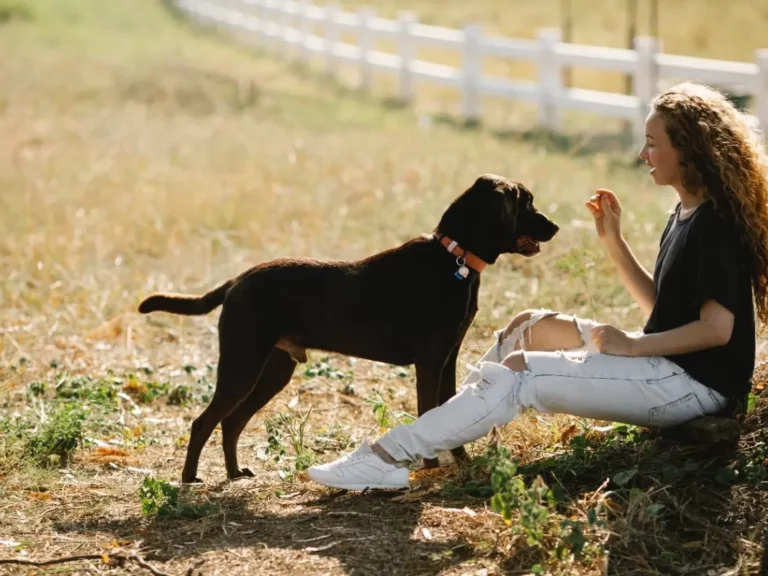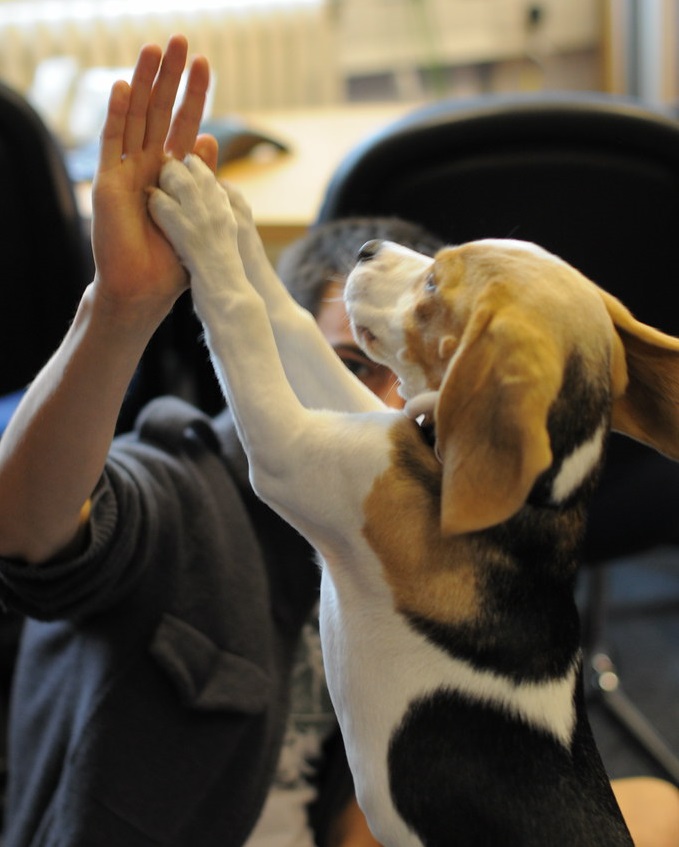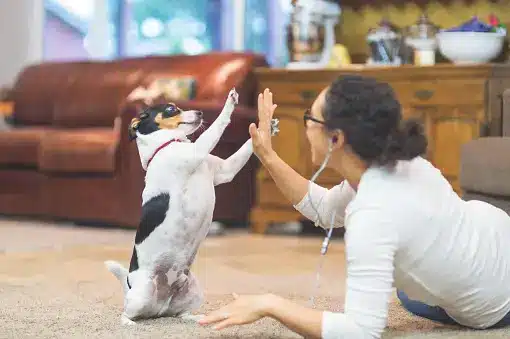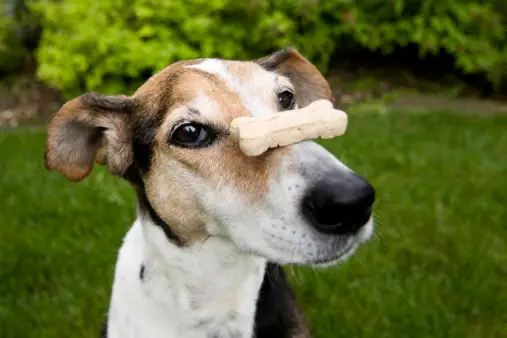Advanced tricks can be taught to smart dogs with our easy guide. Whether you have a highly intelligent breed or simply want to challenge your furry friend, teaching them the crawl, bow, and beg commands can provide mental stimulation and strengthen your bond. These tricks not only impress friends and family but also provide a fun and rewarding activity for both you and your dog. Join us as we delve into the step-by-step process of teaching these advanced tricks and discover the benefits they offer for your canine companion’s overall well-being.
Crawl
Teaching Your Dog to Crawl
Teaching your dog to crawl can be a fun and entertaining trick that will impress your friends and family. It requires some patience and consistency, but with the right approach, you can successfully teach your dog this adorable trick.
Here are some steps to help you teach your dog to crawl:
- Start with a basic command: Before you begin teaching your dog to crawl, make sure they have a good understanding of basic commands such as sit and stay. This will make the training process easier and more effective.
- Use treats as motivation: Treats are a great way to motivate your dog during training. Hold a treat close to your dog’s nose and slowly move it towards the ground. As your dog follows the treat with their nose, they will naturally lower their body to the ground, encouraging them to crawl.
- Add a verbal cue: Once your dog starts to lower their body to the ground, add a verbal cue such as “crawl” or “down.” Repeat this cue consistently every time you practice the trick, so your dog associates the word with the action.
- Gradually increase the distance: Once your dog understands the concept of crawling, gradually increase the distance they need to crawl. Start with just a few inches and gradually increase it over time. Remember to reward your dog with treats and praise each time they successfully crawl.
Benefits of Teaching Your Dog to Crawl
Teaching your dog to crawl isn’t just a cute trick; it also offers several benefits for your dog’s mental and physical well-being. Here are some of the benefits:
- Mental stimulation: Learning new tricks like crawling can provide mental stimulation for your dog. It challenges their problem-solving skills and keeps their mind active and engaged.
- Physical exercise: Crawling requires your dog to use their muscles and engage in physical activity. It can help improve their coordination, balance, and overall fitness.
- Bonding and communication: Training your dog to crawl strengthens the bond between you and your furry friend. It enhances communication and trust, as you work together to learn and perform the trick.
- Impressive and entertaining: Teaching your dog to crawl is a great way to show off their skills and entertain others. Whether it’s at home or in social gatherings, your dog’s crawling trick is sure to be a crowd-pleaser.
Common Mistakes to Avoid when Teaching Crawl
While teaching your dog to crawl, it’s important to avoid certain common mistakes that can hinder their progress. Here are some mistakes to avoid:
- Moving too quickly: Dogs learn at different paces, so it’s crucial to be patient and not rush the training process. Moving too quickly can confuse your dog and make it difficult for them to understand what you want them to do.
- Lack of consistency: Consistency is key when teaching your dog any new trick, including crawling. Use the same verbal cues and practice regularly to reinforce the training. Inconsistency can lead to confusion and slow down the learning process.
- Using force or punishment: Never use force or punishment when training your dog. Positive reinforcement is the most effective and humane way to teach your dog to crawl. Reward their progress with treats, praise, and affection.
- Neglecting practice sessions: Regular practice is essential for your dog to master the crawling trick. Skipping practice sessions can cause your dog to forget the command or lose interest in learning. Make sure to set aside dedicated time for training each day.
By following these tips and avoiding common mistakes, you can successfully teach your dog to crawl. Remember to be patient, use positive reinforcement, and make the training sessions enjoyable for both you and your furry companion.
Bow
Teaching Your Dog to Bow
Teaching your dog to bow can be a fun and impressive trick that will surely impress your friends and family. Follow these simple steps to teach your dog how to bow:
- Start by getting your dog’s attention and making sure they are in a calm and relaxed state.
- Hold a treat in front of your dog’s nose, close to the ground.
- Slowly move the treat towards your dog’s chest, encouraging them to lower their front legs.
- As your dog starts to lower their front legs, use a verbal cue like “bow” or “take a bow” to associate the action with the command.
- Once your dog is in the bow position, reward them with the treat and lots of praise.
- Practice this command daily, gradually reducing the use of the treat until your dog can perform the bow without needing a reward.
Remember to be patient and consistent with your training. Some dogs may learn this trick quickly, while others may take more time. Keep training sessions short and positive, and always end on a positive note.
Benefits of Teaching Your Dog to Bow
Teaching your dog to bow not only provides entertainment value, but it also offers several benefits:
- Mental stimulation: Training your dog to perform tricks like bowing engages their mind and helps prevent boredom. Mental stimulation is crucial for a dog’s overall well-being and can help prevent behavioral issues.
- Bonding: Training sessions create an opportunity for you and your dog to bond and strengthen your relationship. Working together towards a common goal builds trust and communication.
- Physical exercise: The bow command requires your dog to engage their muscles and stretch, providing a mild form of physical exercise. Regular exercise is essential for a dog’s health and can contribute to their overall fitness.
- Impressive trick: Bowing is a unique and eye-catching trick that can impress your friends and family. It showcases your dog’s intelligence and obedience, leaving a lasting impression.
Tips for Perfecting the Bow Command
To ensure your dog masters the bow command, consider the following tips:
- Break it down: If your dog is struggling with the full bow, break the trick down into smaller steps. Teach them to lower one front leg first and gradually progress to both legs.
- Use positive reinforcement: Positive reinforcement is essential in training. Reward your dog with treats, praise, and affection whenever they successfully perform the bow. This will motivate them to continue learning and improve.
- Be consistent: Consistency is key in training. Use the same verbal cue, hand gesture, and reward system each time you practice the bow command. Consistency will help your dog understand what is expected of them.
- Practice in different environments: Once your dog has mastered the bow command indoors, gradually introduce distractions and practice in different environments. This will help your dog generalize the command and perform it reliably in any situation.
- Keep sessions short: Dogs have short attention spans, so keep training sessions short and focused. Five to ten-minute sessions a few times a day are more effective than one long session.
Remember, every dog is unique and may learn at their own pace. Celebrate their progress and enjoy the training journey together!
Beg
Teaching Your Dog to Beg
Teaching your dog to beg is not only an adorable trick but also a great way to engage and bond with your furry friend. With a bit of patience and consistent training, you can have your smart dog begging on command in no time. Here are some steps to help you teach your dog to beg:
- Start with the basics: Before teaching your dog to beg, make sure they have mastered some basic commands such as sit and stay. This will provide a foundation for them to understand and follow your instructions.
- Find the right position: To teach your dog to beg, you need to determine the position that works best for them. Most dogs are comfortable begging by sitting on their hind legs while keeping their front paws off the ground. Experiment with different positions to find the one that suits your dog the most.
- Use treats as rewards: Positive reinforcement is key when training your dog. Use small, tasty treats as rewards to motivate them during the training process. Start by holding a treat in front of your dog’s nose and slowly raise it upwards, encouraging them to lift their front paws off the ground. Once they do, reward them with the treat and praise them enthusiastically.
- Practice regularly: Consistency is crucial when teaching your dog to beg. Set aside regular training sessions of about 10-15 minutes each day to work on this trick. Remember to be patient and repeat the steps as many times as necessary until your dog understands what you want them to do.
Benefits of Teaching Your Dog to Beg
Teaching your dog to beg offers several benefits beyond just being a cute party trick. Here are some advantages of this training:
- Mental stimulation: Begging requires your dog to focus and follow your commands, which stimulates their brain and helps keep their mind sharp. This mental exercise can prevent boredom and provide a healthy outlet for their energy.
- Strengthening the bond: Training sessions, including teaching your dog to beg, are excellent opportunities to strengthen the bond between you and your furry companion. Working together on a task builds trust, improves communication, and deepens your relationship.
- Impressing others: Let’s face it, having a dog that can beg on command is impressive to friends, family, and even strangers. It showcases your dog’s intelligence and obedience, making them a standout among their furry peers.
Avoiding Bad Habits while Teaching Beg
While teaching your dog to beg can be a fun and rewarding experience, it’s important to avoid developing bad habits during the training process. Here are some tips to keep in mind:
- Don’t force your dog: Each dog learns at their own pace, so it’s essential to be patient and never force them into a begging position. Forcing them can lead to discomfort or injury, and it may create a negative association with the trick.
- Use positive reinforcement: Positive reinforcement, such as treats and praise, should be the main focus of your training. Avoid using punishment or negative reinforcement as it can confuse and discourage your dog.
- Be consistent with commands: Use clear and consistent commands while teaching your dog to beg. Stick to a specific cue, such as “beg” or “up,” and avoid using different words or phrases for the same action. This consistency will help your dog understand what is expected of them.
By following these guidelines, you can successfully teach your dog to beg while ensuring a positive and enjoyable training experience for both of you. So grab some treats, get ready to have fun, and watch as your furry friend masters this adorable trick!
In this guide “Advanced Tricks for Smart Dogs: Crawl, Bow, and Beg” we have explored various advanced tricks that can be taught to smart dogs. From learning how to crawl to mastering the art of bowing and begging, these tricks not only showcase a dog’s intelligence but also provide mental stimulation and strengthen the bond between dogs and their owners. By following the step-by-step instructions provided in the article, dog owners can effectively train their pets to perform these impressive tricks. So, whether you have a smart dog or are looking to challenge your furry friend, incorporating these advanced tricks into their training routine can lead to a happier and more fulfilling life for both you and your four-legged companion.






